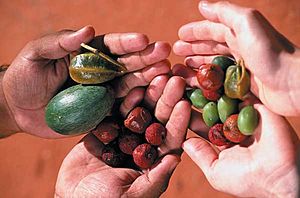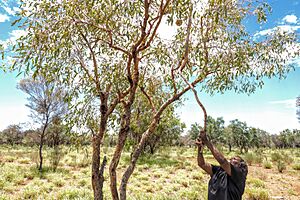Bush tucker facts for kids

Bush tucker in Alice Springs
|
|
| Country or region | Australia |
|---|---|
| Ethnic group | Indigenous Australians |
Bush tucker, also known as bush food, refers to any food that naturally grows in Australia and was traditionally eaten by Indigenous Australians, including the Aboriginal and Torres Strait Islander peoples. It can also mean any native plants, animals, or fungi used for food or medicine, no matter where they come from. Some examples of native animal foods are kangaroo, emu, witchetty grubs, and crocodile. Plant foods include fruits like quandong and kutjera, spices such as lemon myrtle, and vegetables like warrigal greens and different native yams.
When non-Indigenous people settled Australia starting in 1788, it greatly changed how Indigenous Australians used bushfoods. New plants and animals were brought in, and traditional lands and habitats were lost or damaged. This made it much harder for Aboriginal people to find and use their native foods.
However, since the 1970s, more people have realized how healthy and tasty native Australian foods are. The bushfood industry has grown a lot. Kangaroo meat has been sold in supermarkets since the 1980s. Many other bushfoods are now served in restaurants or sold as special gourmet items. This has led to more farms growing native food crops.
Contents
History of Bush Tucker

Aboriginal Australians have eaten native animal and plant foods for thousands of years. They used many traditional ways to prepare and cook their food. It's thought that Aboriginal peoples used about 5,000 different kinds of native foods. Much of this food couldn't be eaten raw or tasted bad without preparation. So, they cooked food over open fires, boiled it in bark containers, mashed vegetables and seeds, or soaked bags of food in running water.
Bush Tucker and Early Settlers
Bush tucker also helped the early non-Indigenous settlers survive, especially when their own food supplies were low. However, many settlers didn't know much about Australian native foods and often thought they were not as good as the familiar foods from their home countries.
In areas where more settlers lived, Aboriginal people often started to eat non-native foods instead of their traditional ones. This change was made even bigger because they lost their traditional lands, which meant they had less access to native foods. Also, native habitats were destroyed to make way for farms.
Bush Tucker Today
The macadamia nut was the first native Australian food plant to be grown on a large scale for sale, starting in the 1880s. However, most of its commercial growth happened in Hawaii. Other native food plants weren't grown commercially until the 1990s.
From the 1970s, non-Indigenous Australians began to notice native Australian foods more. Books like Wildfoods in Australia (1981) became popular. In the late 1970s, plant experts started looking at native food plants to see if they could be grown for sale.
In 1980, the state of South Australia made it legal to sell kangaroo meat for people to eat. Now, you can often find it in supermarkets. It's popular because it's a very lean meat and healthy. Studies show that many bushfoods are very nutritious. In the mid-1980s, some restaurants in Sydney started using native Australian ingredients in their dishes. This was the first time many non-Indigenous Australians could try bushfoods in a fancy, gourmet way.
After popular TV shows about "bush tucker," interest grew even more in the late 1980s. Many books were published, like Bushfood: Aboriginal Food and Herbal Medicine by Jennifer Isaacs and The Bushfood Handbook by Vic Cherikoff.
One great thing about growing native foods is that they are already well-suited to Australia's environment, even in tough conditions. This makes them good for the environment. At first, bush tucker ingredients were collected from the wild. But now, growing them on farms has become more important to make sure there's enough for the growing market. Some Aboriginal communities are also involved in supplying these foods. Even though the industry started with Aboriginal knowledge, Aboriginal people are still not very involved in selling bush tucker commercially, mostly just supplying it. Organizations are working to help more Aboriginal people join the bush tucker market. Special processed food and dried food made from bush tucker are now sold in Australia and to other countries.
The word "bushfood" is a newer term for native Australian food. It came from the older term "bush tucker," which was used in the 1970s and 1980s.
Today, many restaurants serve emu, crocodile, yabbies (a type of freshwater crayfish), and local eels. They also use native plant spices for flavor. Farmers and producers across Australia have started growing these foods for the new markets. Examples include Tasmanian pepper, Victorian eel farms, and South Australian farms growing quandongs, bush tomatoes, and native citrus fruits.
In 2020, scientists at the University of Queensland studied a fruit called the green plum (Buchanania obovata). This fruit grows in Arnhem Land in the Northern Territory. Indigenous people have eaten it for over 53,000 years, but it was not well-known by non-Indigenous people. The scientists learned about it from people in the remote community of Yirrkala. The green plum is picked after the Kakadu plum harvest. Tests showed it has lots of protein, dietary fibre, and minerals like potassium, phosphorus, and magnesium. It also has one of the highest levels of folate among fruits sold today. Scientists are looking into whether it can become a commercial crop for Indigenous communities.
Types of Bush Foods
Some toxic seeds, like those from Cycas media and Moreton Bay chestnut, need to be specially treated to remove poisons before they can be eaten. Many foods are also baked in hot campfire coals or cooked for several hours in ground ovens. Melaleuca tree bark, also known as "Paperbark", is often used to wrap food cooked in ground ovens. Bush bread was made by women using different seeds, nuts, and grains to create flour or dough. Some animals, like kangaroos, were cooked in their own skin, while others, like turtles, were cooked in their shells.
Kangaroo meat is quite common and can be found in Australian supermarkets. It's often cheaper than beef. Other animals, such as emu, goanna (a type of lizard), and witchetty grubs, are also eaten by Aboriginal Australians. Fish and shellfish are important foods for Australian communities living near the coast.
Examples of native Australian plant foods include fruits like quandong, kutjera, muntries, riberry, Davidson's plum, and finger lime. Native spices include lemon myrtle, mountain pepper, and the kakadu plum. Various native yams are valued as food, and a popular leafy vegetable is warrigal greens. Nuts include bunya nut and the macadamia nut, which is the most well-known bush tucker plant grown and sold in large amounts. While not much is known about Aboriginal uses of fungi, beefsteak fungus and native "bread" (also a fungus) were definitely eaten.
Images for kids
-
Billardiera scandens is also known as Apple Dumplings.
See also
 In Spanish: Bush food para niños
In Spanish: Bush food para niños


